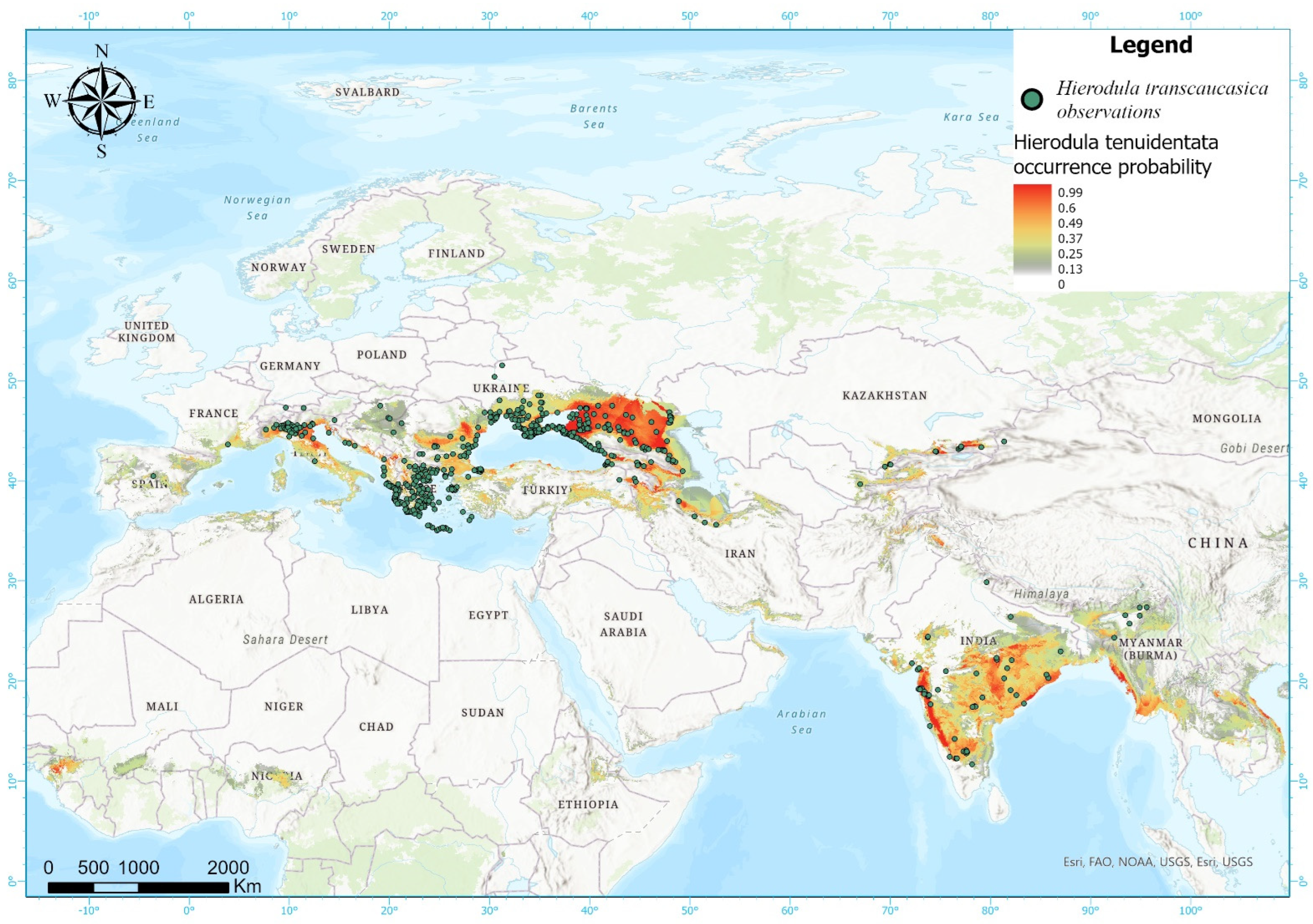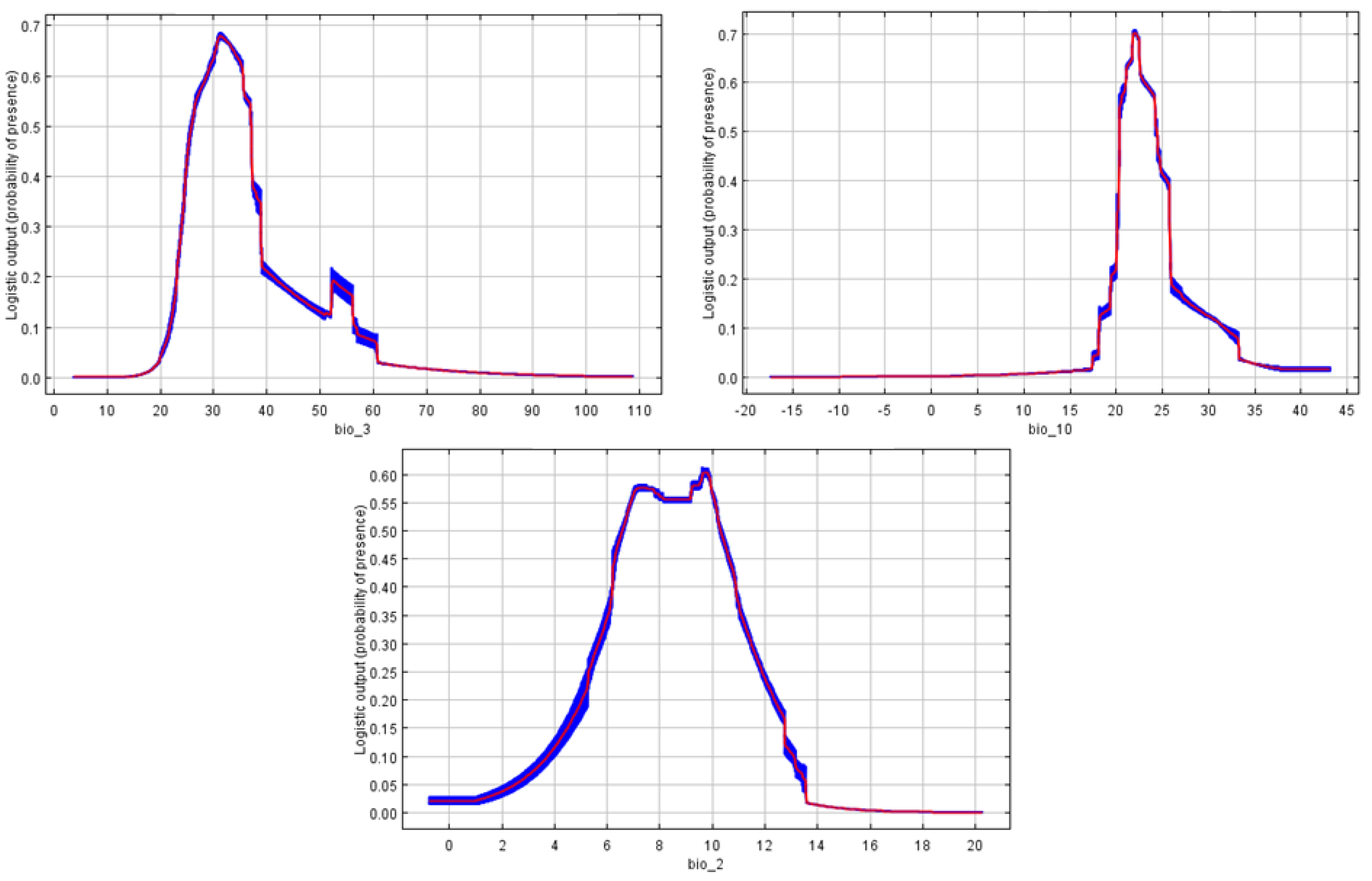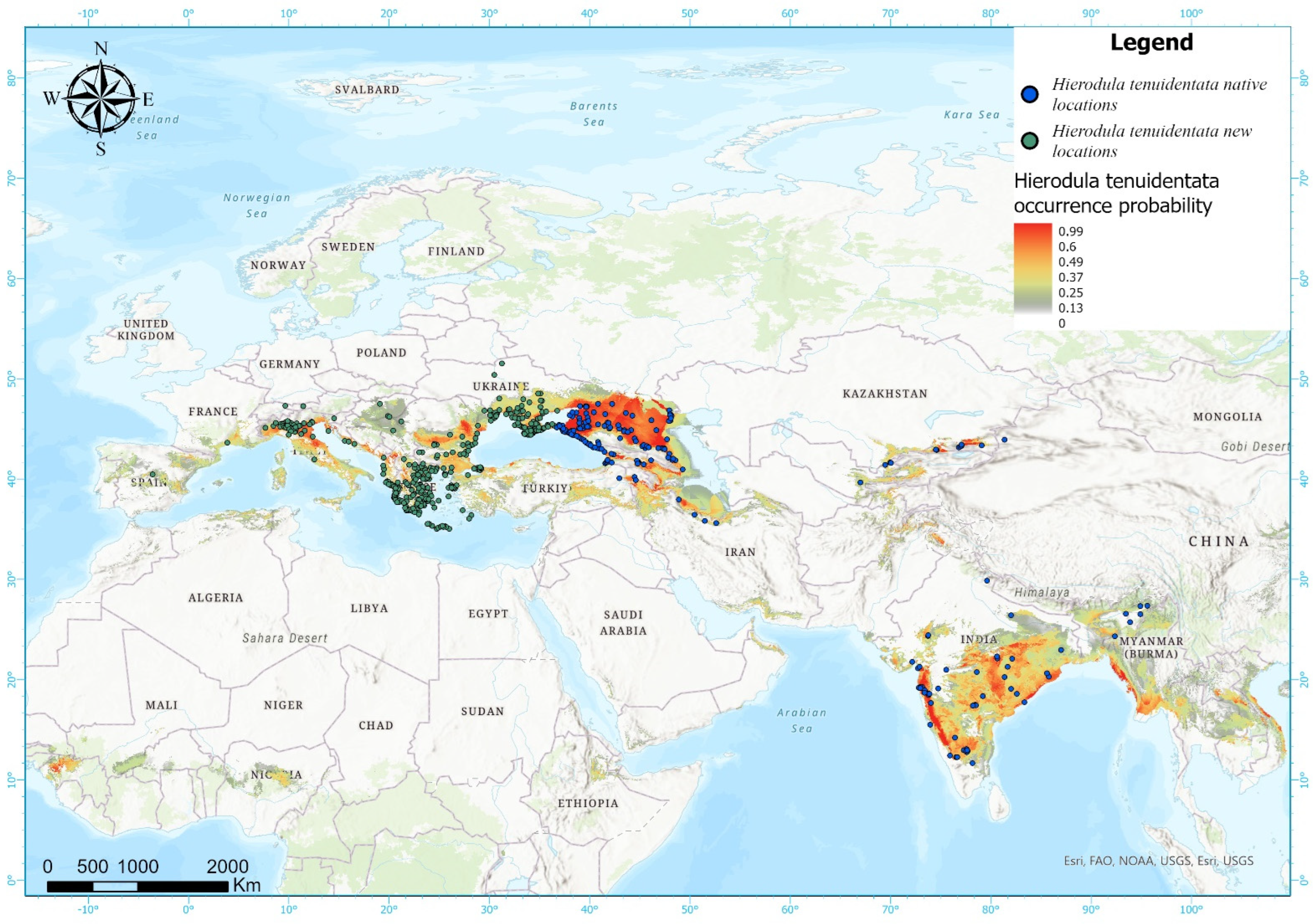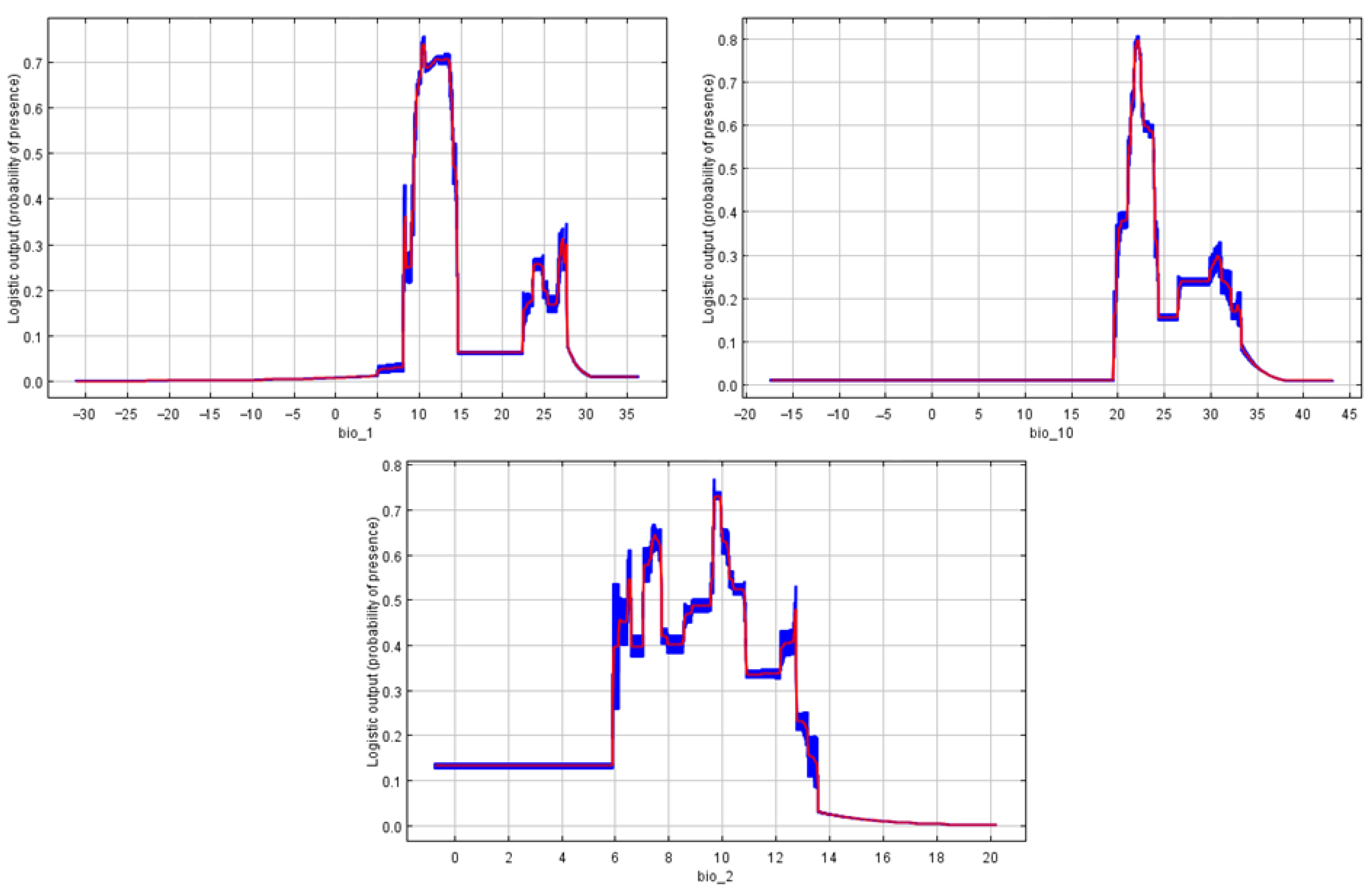Climatic Niche of an Invasive Mantid Species in Europe: Predicted New Areas for Species Expansion
Abstract
1. Introduction
2. Material and Methods
2.1. Mantis Occurrence Data
2.2. Environmental Variables
2.3. Species Distribution Models
2.4. Model Evaluation
3. Results
4. Discussion
Author Contributions
Funding
Acknowledgments
Conflicts of Interest
References
- Mao, M.; Chen, S.; Ke, Z.; Qian, Z.; Xu, Y. Using MaxEnt to Predict the Potential Distribution of the Little Fire Ant (Wasmannia auropunctata) in China. Insects 2022, 13, 1008. [Google Scholar] [CrossRef] [PubMed]
- Guisan, A.; Thuiller, W. Predicting species distribution: Offering more than simple habitat models. Ecol. Lett. 2005, 8, 993–1009. [Google Scholar] [CrossRef] [PubMed]
- Lourenço-de-Moraes, R.; Lansac-Toha, F.M.; Schwind, L.T.F.; Arrieira, R.L.; Rosa, R.R.; Terribile, L.C.; Lemes, P.; Fernando Rangel, T.; Diniz-Filho, J.A.F.; Bastos, R.P.; et al. Climate change will decrease the range size of snake species under negligible protection in the Brazilian Atlantic Forest hotspot. Sci. Rep. 2019, 9, 8523. [Google Scholar] [CrossRef]
- Fridley, J.D.; Stachowicz, J.; Naeem, S.; Sax, D.; Seabloom, E.; Smith, M.; Stohlgren, T.; Tilman, D.; Holle, B.V. The invasion paradox: Reconciling pattern and process in species invasions. Ecology 2007, 88, 3–17. [Google Scholar] [CrossRef]
- Bellard, C.; Leroy, B.; Thuiller, W.; Rysman, J.F.; Courchamp, F. Major drivers of invasion risks throughout the world. Ecosphere 2016, 7, e01241. [Google Scholar] [CrossRef]
- Gallardo, B.; Aldridge, D.C. The ‘dirty dozen’: Socio-economic factors amplify the invasion potential of 12 high-risk aquatic invasive species in Great Britain and Ireland. J. Appl. Ecol. 2013, 50, 757–766. [Google Scholar] [CrossRef]
- McKinney, M.; Kark, S. Factors shaping avian alien species richness in Australia vs Europe. Divers. Distrib. 2017, 23, 1334–1342. [Google Scholar] [CrossRef]
- Spear, D.; Foxcroft, L.C.; Bezuidenhout, H.; McGeoch, M.A. Human population density explains alien species richness in protected areas. Biol. Conserv. 2013, 159, 137–147. [Google Scholar] [CrossRef]
- Marini, L.; Bertolli, A.; Bona, E.; Federici, G.; Martini, F.; Prosser, F.; Bommarco, R. Beta-diversity patterns elucidate mechanisms of alien plant invasion in mountains. Global Ecol. Biogeogr. 2013, 22, 450–460. [Google Scholar] [CrossRef]
- Lazarina, M.; Tsianou, M.A.; Boutsis, G.; Andrikou–Charitidou, A.; Karadimou, E.; Kallimanis, A.S. Urbanization and Human Population Favor Species Richness of Alien Birds. Diversity 2020, 12, 72. [Google Scholar] [CrossRef]
- Gerhold, P.; Pärtel, M.; Tackenberg, O.; Hennekens, S.M.; Bartish, I.; Schaminée, J.H.; Fergus, A.J.; Ozinga, W.A.; Prinzing, A. Phylogenetically poor plant communities receive more alien species, which more easily coexist with natives. Am. Nat. 2011, 177, 668–680. [Google Scholar] [CrossRef]
- Levine, J.M.; Adler, P.B.; Yelenik, S.G. A meta-analysis of biotic resistance to exotic plant invasions. Ecol. Lett. 2004, 7, 975–989. [Google Scholar] [CrossRef]
- Loiola, P.P.; de Bello, F.; Chytrý, M.; Götzenberger, L.; Carmona, C.P.; Pyšek, P.; Lososová, Z. Invaders among locals: Alien species decrease phylogenetic and functional diversity while increasing dissimilarity among native community members. J. Ecol. 2018, 106, 2230–2241. [Google Scholar] [CrossRef]
- Helsen, K.; Van Cleemput, E.; Bassi, L.; Graae, B.J.; Somers, B.; Blonder, B.; Honnay, O. Inter-and intraspecific trait variation shape multidimensional trait overlap between two plant invaders and the invaded communities. Oikos 2020, 129, 677–688. [Google Scholar] [CrossRef]
- Patel, S.; Singh, R. Updated Checklist and Distribution of Mantidae (Mantodea: Insecta) of the World. Int. J. Res. Stud. Zool. 2016, 2, 17–54. [Google Scholar] [CrossRef]
- Global Biodiversity Information Facility 2023a. GBIF Occurrence Download Hierodula transcaucasica. Available online: https://www.gbif.org/occurrence/download/0000125-230224095556074 (accessed on 29 November 2022).
- Global Biodiversity Information Facility 2023b. GBIF Occurrence Download Hierodula tenuidentata. Available online: https://www.gbif.org/occurrence/download/0182962-220831081235567 (accessed on 29 November 2022).
- Battison, R.; Leandri, F.; di Pietro, W.; Andria, S. The giant Asian mantis Hierodula tenuidentata Saussure, 1869 spreads in Italy: A new invasive alien species for the European fauna (Insecta Mantodea). Biodivers. J. 2018, 9, 399–404. [Google Scholar] [CrossRef]
- Boria, R.A.; Olson, L.E.; Goodman, S.M.; Anderson, R.P. Spatial filtering to reduce sampling bias can improve the performance of ecological niche models. Ecol. Model. 2014, 275, 73–77. [Google Scholar] [CrossRef]
- Fick, S.E.; Hijmans, R.J. WorldClim 2: New 1 km spatial resolution climate surfaces for global land areas. Int. J. Climatol. 2017, 37, 4302–4315. [Google Scholar] [CrossRef]
- Dormann, C.F.; Elith, J.; Bacher, S.; Buchmann, C.; Carl, G.; Carre, G.; García Marquéz, J.R.; Gruber, B.; Lafourcade, B.; Leitao, P.J.; et al. Collinearity: A review of methods to deal with it and a simulation study evaluating their performance. Ecography 2013, 36, 27–46. [Google Scholar] [CrossRef]
- Hair, J.F.; Black, W.C.; Babin, B.J.; Anderson, R.E.; Tatham, R.L. Multivariate Data Analysis. Upper Saddle River: Pearson Prentice Hall; Prentice-Hall, Inc.: Upper Saddle River, NJ, USA, 2006. [Google Scholar]
- Harding, T.; Tusell Fernando Cat. Analysis and Imputation of Categorical-Variable Datasets with Missing Values. Available online: https://cran.r-project.org/web/packages/cat/index.html (accessed on 24 February 2023).
- Elith, J.; Phillips, S.J.; Hastie, T.; Dudik, M.; Chee, Y.E.; Yates, C.J. A statistical explanation of MaxEnt for ecologists. Divers. Distrib. 2011, 17, 43–57. [Google Scholar] [CrossRef]
- Sutton, L.J.; Puschendorf, R. Climatic niche of the Saker Falcon Falco cherrug: Predicted new areas to direct population surveys in Central Asia. Ibis 2018, 162, 27–41. [Google Scholar] [CrossRef]
- Fehervari, P.; Solt, S.; Palatitz, P.; Barna, K.; Agoston, A.; Gergely, J.; Nagy, A.; Nagy, K.; Harnos, A. Allocating active conservation measures using species distribution models: A case study of Red-footed Falcon breeding site management in the Carpathian Basin. Anim. Conserv. 2012, 15, 648–657. [Google Scholar] [CrossRef]
- Franklin, J. Species distribution models in conservation biogeography: Developments and challenges. Divers. Distrib. 2013, 19, 1217–1223. [Google Scholar] [CrossRef]
- Pintilioaie, A.-M.; Spaseni, P.; Jurjescu, A.; Rădac, I.A. First record of the alien mantid Hierodula tenuidentata (Insecta: Mantodea) in Romania. Trav. Muséum Natl. D’histoire Nat. “Grigore Antipa” 2021, 64, 37–49. [Google Scholar] [CrossRef]
- Werner, F. Zur Kenntnis afrikanischer und indischer Mantodeen. Verh. Kais.-Königlichen Zool.-Bot. Ges. Wien 1916, 66, 254–296. (In German) [Google Scholar]
- Ehrmann, R. Mantodea from Turkey and Cyprus (Dictyoptera: Mantodea). Articulata 2011, 26, 1–42. [Google Scholar]
- Pushkar, T.; Kavurka, V.V. New data about the distribution of Hierodula transcaucasica in Ukraine. Abstracts of I (IV) International Scientific and Practical Meeting “Probl. Mod. Entomol.” Uzhgorod, 15–17 September 2016. Ukr. Entomofaunistyka 2016, 7, 77–78. (In Russian) [Google Scholar]
- Vujić, M.; Ivković, S. New records of allochthonous Hierodula tenuidentata Saussure, 1869 (Mantodea: Mantidae) from Southeastern Europe, with evidence of its spread across the pannonian plain. Nat. Croat. 2023, 32, 69–79. [Google Scholar]
- Moulin, N.; Rouard, J. Hierodula transcaucasica continues its invasion of Western Europe (Mantodea, Mantidae). Bull. Société Entomol. Fr. 2023, 128, 103–107. [Google Scholar] [CrossRef]
- Moulin, N. When citizen science highlights alien invasive species in France: The case of Indochina mantis, Hierodula petallifera (Insecta, Mantodea, Mantidae). Biodivers. Data J. 2020, 8, e46989. [Google Scholar] [CrossRef]
- Pintilioaie, A.-M.; Filote, B.D.; Sfîcă, L.; Baltag, E.Ș. Weather Influence on Native and Alien Mantises Dynamics and Their Abundance in the Current Climate Change Conditions. Sustainability 2022, 14, 1586. [Google Scholar] [CrossRef]





| Variable Name | Variable Abbreviation | Variable Recording |
|---|---|---|
| Minimum air temperature | T_min | Monthly minimum temperature (°C): 1970–2000 |
| Maximum air temperature | T_max | Monthly maximum temperature (°C): 1970–2000 |
| Mean air temperature | T_med | Month mean temperature (°C): 1970–2000 |
| Precipitation amount per day | Pp | Month mean precipitations (mm): 1970–2000 |
| Solar radiation | Sr | Solar radiation (kJ m-2 day-1) for 1970–2000 |
| Wind speed | Ws | Wind speed (m s-1) for 1970–2000 |
| Water vapor pressure | Wvp | Water vapor pressure (kPa): 1970–2000 |
| Annual Mean Temperature | BIO 01 | Annual Mean Temperature (°C): 1970–2000 |
| Mean Diurnal Range | BIO 02 | Mean Diurnal Range (Mean of monthly (max temp–min temp)): 1970–2000 |
| Isothermality | BIO 03 | Isothermality (BIO2/BIO7) (×100): 1970–2000 |
| Temperature Seasonality | BIO 04 | Temperature Seasonality (standard deviation ×100): 1970–2000 |
| Max Temperature of Warmest Month | BIO 05 | Max Temperature of Warmest Month (°C): 1970–2000 |
| Min Temperature of Coldest Month | BIO 06 | Min Temperature of Coldest Month (°C): 1970–2000 |
| Temperature Annual Range | BIO 07 | Temperature Annual Range (BIO5-BIO6): 1970–2000 |
| Mean Temperature of Wettest Quarter | BIO 08 | Mean Temperature of Wettest Quarter (°C): 1970–2000 |
| Mean Temperature of Driest Quarter | BIO 09 | Mean Temperature of Driest Quarter (°C): 1970–2000 |
| Mean Temperature of Warmest Quarter | BIO 10 | Mean Temperature of Warmest Quarter (°C): 1970–2000 |
| Mean Temperature of Coldest Quarter | BIO 11 | Mean Temperature of Coldest Quarter (°C): 1970–2000 |
| Annual Precipitation | BIO 12 | Annual Precipitation (mm): 1970–2000 |
| Precipitation of Wettest Month | BIO 13 | Precipitation of Wettest Month (mm): 1970–2000 |
| Precipitation of Driest Month | BIO 14 | Precipitation of Driest Month (mm): 1970–2000 |
| Precipitation Seasonality | BIO 15 | Precipitation Seasonality (Coefficient of Variation) |
| Precipitation of Wettest Quarter | BIO 16 | Precipitation of Wettest Quarter (mm): 1970–2000 |
| Precipitation of Driest Quarter | BIO 17 | Precipitation of Driest Quarter (mm): 1970–2000 |
| Precipitation of Warmest Quarter | BIO 18 | Precipitation of Warmest Quarter (mm): 1970–2000 |
| Precipitation of Coldest Quarter | BIO 19 | Precipitation of Coldest Quarter (mm): 1970–2000 |
| Elevation | Elev | Elevation (m) |
| Distribution Model | AUC Train | AUC Test | AUC Difference | AUC sd |
|---|---|---|---|---|
| Complete (native and new locations) | 0.967 | 0.960 | 0.07 | 0.007 |
| Native presence | 0.988 | 0.965 | 0.025 | 0.015 |
Disclaimer/Publisher’s Note: The statements, opinions and data contained in all publications are solely those of the individual author(s) and contributor(s) and not of MDPI and/or the editor(s). MDPI and/or the editor(s) disclaim responsibility for any injury to people or property resulting from any ideas, methods, instructions or products referred to in the content. |
© 2023 by the authors. Licensee MDPI, Basel, Switzerland. This article is an open access article distributed under the terms and conditions of the Creative Commons Attribution (CC BY) license (https://creativecommons.org/licenses/by/4.0/).
Share and Cite
Pintilioaie, A.-M.; Sfîcă, L.; Baltag, E.S. Climatic Niche of an Invasive Mantid Species in Europe: Predicted New Areas for Species Expansion. Sustainability 2023, 15, 10295. https://doi.org/10.3390/su151310295
Pintilioaie A-M, Sfîcă L, Baltag ES. Climatic Niche of an Invasive Mantid Species in Europe: Predicted New Areas for Species Expansion. Sustainability. 2023; 15(13):10295. https://doi.org/10.3390/su151310295
Chicago/Turabian StylePintilioaie, Alexandru-Mihai, Lucian Sfîcă, and Emanuel Stefan Baltag. 2023. "Climatic Niche of an Invasive Mantid Species in Europe: Predicted New Areas for Species Expansion" Sustainability 15, no. 13: 10295. https://doi.org/10.3390/su151310295
APA StylePintilioaie, A.-M., Sfîcă, L., & Baltag, E. S. (2023). Climatic Niche of an Invasive Mantid Species in Europe: Predicted New Areas for Species Expansion. Sustainability, 15(13), 10295. https://doi.org/10.3390/su151310295






